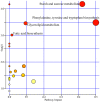Identification of Potential Metabolite Markers for Middle-Aged Patients with Post-Stroke Depression Using Urine Metabolomics
- PMID: 32922015
- PMCID: PMC7457842
- DOI: 10.2147/NDT.S271990
Identification of Potential Metabolite Markers for Middle-Aged Patients with Post-Stroke Depression Using Urine Metabolomics
Abstract
Background: Post-stroke depression (PSD) is one of the most common complications in stroke survivors. But, there are still no objective methods to diagnose PSD. This study aims to identify potential biomarkers for diagnosing PSD in middle-aged stroke survivors.
Methods: Middle-aged subjects aged 30 to 59 years (92 PSD patients and 89 stroke survivors without depression) were included in this study. Urinary metabolites were detected by gas chromatography-mass spectrometry (GC-MS). Differential urinary metabolites and potential biomarkers were screened by applying statistical analysis.
Results: The different urinary metabolic phenotypes between PSD patients and stroke survivors without depression were identified. A total of 12 differential urinary metabolites were accurately identified by using orthogonal partial least-squares-discriminant analysis. After analyzing those 12 differential urinary metabolites by step-wise logistic regression analysis, only seven metabolites (palmitic acid, hydroxylamine, myristic acid, glyceric acid, lactic acid, tyrosine and azelaic acid) were finally selected as potential biomarkers for diagnosing PSD in middle-aged stroke survivors. A panel consisting of these potential biomarkers could effectively diagnose middle-aged PSD patients.
Conclusion: Urinary metabolic profiles were different between middle-aged PSD patients and stroke survivors without depression. Our results would be helpful in future for developing an objective method to diagnose PSD in middle-aged stroke survivors.
Keywords: biomarkers; metabolites; post-stroke depression.
© 2020 Xie et al.
Conflict of interest statement
The authors declare no financial or other conflicts of interest for this work.
Figures





Similar articles
-
Does urinary metabolite signature act as a biomarker of post-stroke depression?Front Psychiatry. 2022 Aug 24;13:928076. doi: 10.3389/fpsyt.2022.928076. eCollection 2022. Front Psychiatry. 2022. PMID: 36090365 Free PMC article. Review.
-
Urinary Metabolite Signatures for Predicting Elderly Stroke Survivors with Depression.Neuropsychiatr Dis Treat. 2021 Mar 25;17:925-933. doi: 10.2147/NDT.S299835. eCollection 2021. Neuropsychiatr Dis Treat. 2021. PMID: 33790561 Free PMC article.
-
Urinary biomarkers for diagnosing poststroke depression in patients with type 2 diabetes mellitus.Diabetes Metab Syndr Obes. 2019 Aug 13;12:1379-1386. doi: 10.2147/DMSO.S215187. eCollection 2019. Diabetes Metab Syndr Obes. 2019. PMID: 31496775 Free PMC article.
-
A Novel Urinary Metabolite Signature for Non-invasive Post-stroke Depression Diagnosis.Cell Biochem Biophys. 2015 Jul;72(3):661-7. doi: 10.1007/s12013-014-0472-9. Cell Biochem Biophys. 2015. PMID: 27352185
-
The Relationship Between 5-Hydroxytryptamine and Its Metabolite Changes With Post-stroke Depression.Front Psychiatry. 2022 Apr 26;13:871754. doi: 10.3389/fpsyt.2022.871754. eCollection 2022. Front Psychiatry. 2022. PMID: 35558423 Free PMC article. Review.
Cited by
-
Effects of Electroacupuncture on Gut Microbiota and Fecal Metabolites in Rats with Poststroke Depression.Neuropsychiatr Dis Treat. 2023 Jul 12;19:1581-1592. doi: 10.2147/NDT.S415098. eCollection 2023. Neuropsychiatr Dis Treat. 2023. PMID: 37465562 Free PMC article.
-
Does urinary metabolite signature act as a biomarker of post-stroke depression?Front Psychiatry. 2022 Aug 24;13:928076. doi: 10.3389/fpsyt.2022.928076. eCollection 2022. Front Psychiatry. 2022. PMID: 36090365 Free PMC article. Review.
-
Peripheral blood and urine metabolites and biological functions in post-stroke depression.Metab Brain Dis. 2022 Jun;37(5):1557-1568. doi: 10.1007/s11011-022-00984-9. Epub 2022 Apr 19. Metab Brain Dis. 2022. PMID: 35438379
-
Altered Fecal Metabolites and Colonic Glycerophospholipids Were Associated With Abnormal Composition of Gut Microbiota in a Depression Model of Mice.Front Neurosci. 2021 Jul 19;15:701355. doi: 10.3389/fnins.2021.701355. eCollection 2021. Front Neurosci. 2021. PMID: 34349620 Free PMC article.
-
Urinary Metabolite Signatures for Predicting Elderly Stroke Survivors with Depression.Neuropsychiatr Dis Treat. 2021 Mar 25;17:925-933. doi: 10.2147/NDT.S299835. eCollection 2021. Neuropsychiatr Dis Treat. 2021. PMID: 33790561 Free PMC article.
References
LinkOut - more resources
Full Text Sources
Miscellaneous

